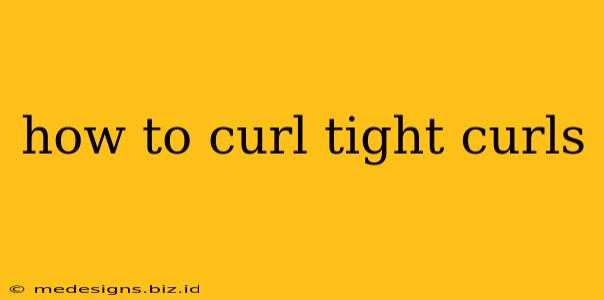Want to achieve those enviable, bouncy tight curls? Whether you're naturally curly and looking to enhance your existing texture or aiming for defined ringlets on straight hair, this guide provides expert tips and tricks to help you master the art of curling tight curls.
Understanding Your Hair Type
Before diving into techniques, understanding your hair type is crucial. Hair texture varies greatly, influencing the best methods for achieving tight curls. Factors to consider include:
- Hair porosity: This refers to your hair's ability to absorb moisture. High porosity hair absorbs moisture quickly, while low porosity hair struggles. This affects product choice and styling techniques.
- Hair density: This is the number of hair strands per square inch. Thicker hair may require more heat or time to curl than thinner hair.
- Hair length: Longer hair can be more challenging to curl tightly, requiring more patience and potentially different techniques.
Methods for Curling Tight Curls
There are several ways to create tight curls, each offering unique advantages:
1. Using a Curling Iron
A curling iron is a popular choice for creating defined, tight curls. Here's how:
- Choose the right barrel size: Smaller barrels (under 1 inch) are ideal for tight curls.
- Prep your hair: Apply a heat protectant spray to minimize damage.
- Section your hair: Working with small sections ensures even curls.
- Curl technique: Hold the section taut, wrap it around the barrel, and hold for a few seconds before releasing.
- Set your curls: Once cooled, gently loosen the curls with your fingers or a wide-tooth comb. Consider using a light-hold hairspray to maintain the shape.
2. Employing Hair Rollers
Hair rollers offer a gentler alternative to heat styling. Here's what you need to know:
- Roller size matters: Smaller rollers create tighter curls.
- Wet or dry hair?: You can use rollers on damp or dry hair, depending on the roller type. Follow the product instructions.
- Setting time: Allow ample time for the rollers to set (this can take several hours, or overnight for best results).
- Removal: Gently unroll the rollers, being careful not to disturb the curls.
3. Braiding for Natural Curls
Braiding is a heat-free method, perfect for those seeking a gentle approach.
- Smaller braids, tighter curls: The smaller your braids, the tighter your curls will be.
- Overnight success: Braid your damp hair before bed and unravel in the morning.
- Maintain the curls: Once unbraided, gently separate the curls with your fingers.
4. Twisting for Defined Curls
Twisting your hair offers another heat-free way to get defined curls. Here's how:
- Section your hair: Section your damp hair into small sections.
- Twisting technique: Twist each section tightly, securing the end with a small clip or hair tie.
- Drying time: Allow your hair to air dry completely or use a diffuser attachment on your hairdryer.
Maintaining Your Tight Curls
Once you've achieved your perfect tight curls, maintaining them requires care:
- Avoid over-brushing: This can cause frizz and loosen your curls. Use your fingers or a wide-tooth comb to detangle.
- Use the right products: Curly hair often benefits from moisturizing products like leave-in conditioners and curl creams to combat frizz and enhance definition.
- Protective hairstyles: Consider protective hairstyles like braids or twists to preserve your curls for longer periods.
Frequently Asked Questions (FAQs)
Q: How can I prevent frizz? Use anti-frizz products, avoid over-manipulating your hair, and consider sleeping on a satin pillowcase.
Q: What type of curling iron is best for tight curls? A curling iron with a small barrel (under 1 inch) is ideal.
Q: How long do tight curls last? This depends on your hair type and the method used. Heat-styled curls generally last longer than heat-free curls.
By following these tips and experimenting with different methods, you'll be well on your way to achieving and maintaining those stunning, tight curls. Remember to be patient and practice – mastering the art of curling takes time and practice!
